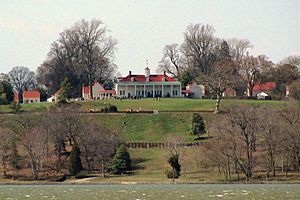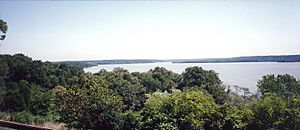Mount Vernon Conference facts for kids
The Mount Vernon Conference was an important meeting held from March 21 to March 28, 1785. Delegates from Virginia and Maryland met to talk about how they would share the waterways between their states. These waterways included the Potomac River, Pocomoke River, and Chesapeake Bay.
On March 28, 1785, the group created a plan with thirteen points. This plan would guide how both states used these rivers and the bay. It was called the Mount Vernon Compact or the Compact of 1785. This agreement covered more than just boat travel. It also included rules about taxes on goods, trade, fishing rights, and collecting debts. Both states' legislatures approved the compact. This meeting helped set an example for future meetings where states could discuss common problems.
Why the Meeting Happened
The United States had just won the American Revolutionary War. But the country had a weak central government under the Articles of Confederation. Because of this, the states often argued with each other. Some states even made their own rules about trade, taxes, and money.
Virginia and Maryland shared important rivers. They knew they needed an agreement to make sure trade could happen easily on these waterways. This led to the creation of the Potomac Company. This company was formed in Maryland in 1784 and in Virginia in 1785. Its goal was to improve the Potomac River. They wanted to make it easier for boats to travel past the fall line. This would help connect the East Coast with the lands west of the trans-Appalachian mountains.

The meeting was supposed to start on March 21, 1785, in Alexandria, Virginia. Maryland's delegates were Samuel Chase, Daniel of St. Thomas Jenifer, and Thomas Stone. Virginia's delegates were Alexander Henderson and George Mason. Other Virginia delegates, like James Madison, were appointed but didn't know about it in time.
When the Maryland delegates arrived, no Virginia delegates were there. George Washington had been talking with Thomas Stone about the meeting. He invited the Maryland delegates to stay at his Mount Vernon estate in Fairfax County, Virginia. Then, he offered to host the meeting there. Washington was not an official delegate. But he knew a lot about the issues and cared about travel on the Potomac. He inspired the delegates and made the meeting seem very important.
The Conference at Mount Vernon
The conference started again at Mount Vernon on March 25, 1785. George Washington led the discussions. Maryland's representatives had the power to talk with Virginia about their shared concerns. These included the Potomac and Pocomoke Rivers and the Chesapeake Bay. However, Virginia's delegates were only told to focus on the Potomac.
Even so, they found common ground. On March 28, they finished a report for both state legislatures. The report had 13 rules. Both Maryland and Virginia approved it. It said that the Potomac River, which was under Maryland's control, would be a common waterway for Virginia to use too. The agreement also set rules for fishing rights. It divided the costs of building navigation aids, like lighthouses. It also called for cooperation on defense and dealing with piracy. The compact also suggested that special commissioners should handle any future problems. Leaders in Pennsylvania and Delaware were invited to join the agreement later.
What Came Next
The Mount Vernon Conference became a great example of states working together. This happened even though the Articles of Confederation didn't really support it. Its success encouraged James Madison to push for more discussions about problems facing the states. He had tried to get Virginia's delegates in the Continental Congress to ask for more power to deal with trade. But that didn't work.
Instead, Madison suggested that Virginia act on the idea from the compact commissioners. This idea was to have more talks about issues between states. Maryland agreed on January 21, 1786. Then, Virginia invited all the states to another meeting about trade. This important meeting was the Annapolis Convention.
The second meeting of states was formally called "A Meeting of Commissioners to Remedy Defects of the Federal Government." It took place in Annapolis, Maryland, on September 11, 1786. Delegates from five states attended. Delegates from four other states either arrived too late or did not come. They met to discuss how to make trade easier between states. They also wanted to set standard rules.
Because of this meeting, the commissioners called for another convention. This one would discuss possible improvements to the Articles of Confederation. This desired convention happened in Philadelphia in the summer of 1787.
The meetings at Annapolis and Mount Vernon helped lead to the Philadelphia Convention. This convention further strengthened the idea of states working together. It resulted in a new Constitution for the federal government. Later, in 1908, a government commission noted how these events were connected. They said that the earliest efforts to improve waterways began with George Washington's influence. This led to the Mount Vernon Conference, then Annapolis, and finally the Constitutional Convention. The Constitution united the states, mainly for trade, which was mostly by water at that time.


